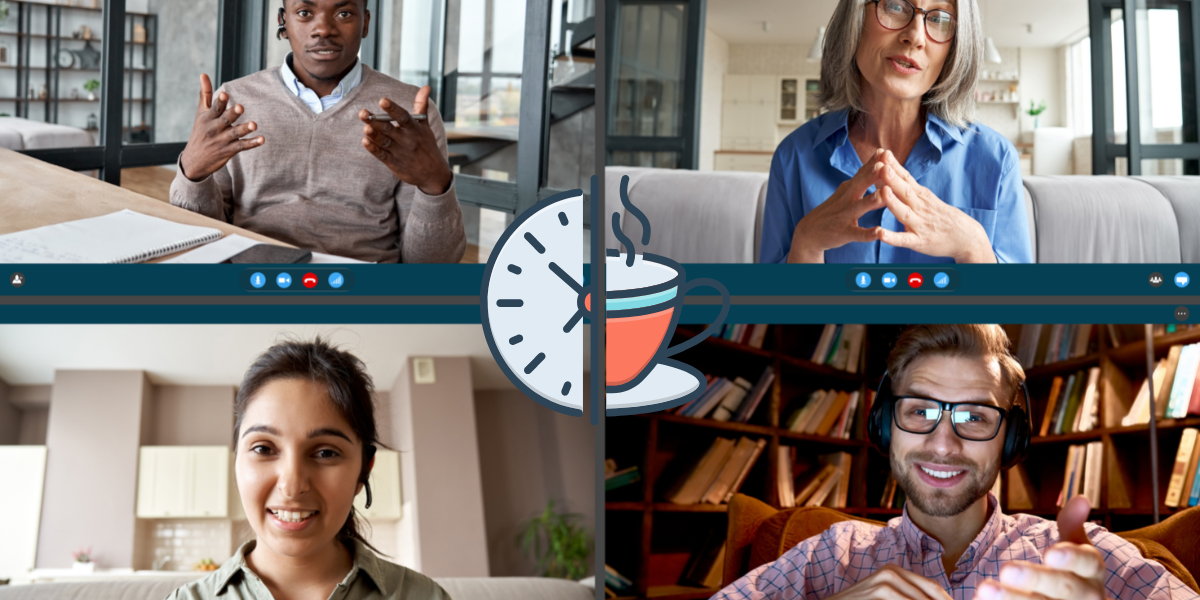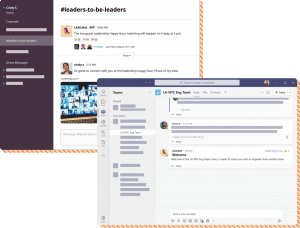When we’re all working remotely, we start to miss the small social interactions. These are not just essential for employee engagement. In fact, virtual coffee chats are a very useful employee engagement tactic and essential for maintaining employee mental wellbeing. These water cooler conversations, coffee breaks with colleagues, chats about our weekends, and sharing snacks in the break room are more than just small talk.
The good news is, even in a remote setting, we can recreate these essential aspects of our work culture with virtual coffee chats on Slack or Microsoft Teams. These platforms can enable us to have scheduled, informal conversations, enhancing employee engagement and promoting mental wellbeing.
Virtual coffee chats on Slack or Microsoft Teams can lower stress levels, increase camaraderie, and reduce errors. With employees having an opportunity to talk and engage more frequently, they can catch each other’s misunderstandings, improving productivity and overall employee mental wellbeing.
LEAD.bot, compatible with both Slack and Microsoft Teams, can help you incorporate these quick, informal meetings into your employees’ everyday routine. This can foster better relationships, drive employee engagement, and enhance their mental wellbeing.
Firstly, What are Virtual Coffee Chat?
A virtual coffee chat is an online meeting where professionals connect and converse in an informal setting, similar to an in-person coffee meet-up, but facilitated through digital platforms. The aim of these chats remains the same as their physical counterparts: building professional relationships, exchanging industry insights, exploring potential collaborations, and facilitating career development.
Virtual coffee chats can take place via various digital communication tools such as Zoom, Microsoft Teams, Google Meet, or other video conferencing platforms. These online meetings provide flexibility and convenience, as participants can join from anywhere, eliminating geographical boundaries and travel time.
The discussions during a virtual coffee chat can cover a wide range of topics, including career aspirations, current projects, industry trends, personal interests, and objectives for the chat. This one-on-one interaction allows for an exchange of ideas and experiences, leading to valuable insights and meaningful connections that can further career advancement.
In addition to fostering professional relationships, virtual coffee chats also offer a platform for refining networking skills in the digital age. Active listening, asking engaging questions, maintaining eye contact (even if through a screen), and ensuring follow-up communication after the chat, are crucial elements of successful virtual networking.
Just like traditional networking, virtual coffee chats require a degree of preparation. It’s important to ensure a stable internet connection, a quiet environment, and familiarize yourself with the chosen video conferencing platform’s functionality to ensure a smooth and productive conversation.
What is a virtual coffee app?
A virtual coffee app is a digital tool designed to facilitate casual, informal interactions among employees in a virtual environment. By randomly pairing colleagues for virtual meet-ups or chats, these apps aim to recreate the spontaneity of office coffee breaks or water cooler conversations in a remote work setting.
A virtual coffee app also provides a host of practical benefits to HR teams in managing and facilitating these virtual meet-ups:
- Time Efficiency: The process of manually pairing employees, checking their availability, and scheduling meet-ups can be time-consuming. A virtual coffee app automates this process, saving significant time and effort for the HR team.
- Manages Opt-ins and Opt-outs: The app can efficiently handle opt-ins and opt-outs, ensuring only interested employees are included in the coffee chat rotations and respecting the preferences of those who choose not to participate.
- Automated Scheduling: Virtual coffee apps can automatically coordinate the schedules of paired employees and set up meetings based on their shared availability. This eliminates the need for back-and-forth scheduling, making the process seamless and efficient.
- Easy Tracking: These apps often include features for tracking participation and engagement, providing HR with valuable data and insights into the effectiveness of these virtual social interactions. This can help inform future strategies for fostering employee engagement and community.
- Scalability: Whether you have a small team or a large workforce, virtual coffee apps can scale to meet the needs of your organization, making them a flexible tool for companies of all sizes.
By leveraging a virtual coffee app, HR teams can effectively facilitate informal networking among employees, while also freeing up their resources to focus on other strategic areas of HR management. Especially with solutions that do post-matching surveys and pre-matching notifications, can further streamline the process and enhance its effectiveness:
- Pre-Matching Notifications: This feature can ensure that all participants are adequately informed about their upcoming virtual coffee chat. These notifications can include details like the date and time of the chat, information about their match, and even suggested conversation starters. This gives participants time to prepare and helps to facilitate more meaningful and engaging conversations.
- Post-Matching Surveys: After the virtual coffee chat, participants can be asked to complete a quick survey about their experience. This can include questions about the usefulness of the chat, the quality of the conversation, any technical issues they encountered, and suggestions for improvement. The feedback obtained from these surveys can be invaluable for HR teams in evaluating the effectiveness of these virtual chats and making necessary improvements.
Benefits of Virtual Coffee Chats
Coffee breaks, though seemingly small, are beneficial for employee engagement and mental wellbeing. In a survey of 2,000 people, 47% of workers found that a coffee break was an essential strategy for relaxing and improving concentration. These breaks, even when virtual on platforms like Slack or Microsoft Teams, help mitigate workplace stress and increase productivity. (Check out the studies “mitigate workplace stress and increase productivity” here. )

Virtual coffee breaks on platforms like Slack or Microsoft Teams are a powerful antidote to feelings of isolation and disconnectedness often experienced by remote workers. By establishing a routine of recurring and consistent meetings with coworkers, we can significantly enhance the network of connections within the company, thus promoting employee engagement and improving mental wellbeing.
Furthermore, these coffee breaks can be instrumental in fostering an internal growth network. These informal interactions allow employees to build stronger relationships with their peers, facilitating collaboration across different teams, projects, and functions. Enhanced inter-departmental communication can lead to an improvement in information flow, innovation, and ultimately, productivity.
Interestingly, improving this collaborative network is a challenge many organizations struggle with, often resorting to costly consulting services. However, a simpler and more organic solution lies in promoting virtual coffee breaks with tools like LEAD.bot. This approach not only offers a cost-effective alternative but also nurtures a more authentic and employee-centric culture of collaboration and connection.
Customers who’ve integrated LEAD.bot into their Slack and Microsoft Teams platforms have reported improved feelings of loneliness among workers. It’s especially beneficial for new hires, helping them acclimate to the workplace even during periods of remote work.
The Dos and Don’ts of a Virtual Coffee Chats & Coffee Matching Program
Do’s:
- Tailor to Shared Interests: Encourage matching within groups that share similar interests. This was a strategy successfully employed by Filip Chrześcijanek, a former senior engineer at Oakfusion. He invited LEAD.bot to the #podcast-listeners channel in Slack, initiating matches among podcast enthusiasts and keeping the virtual meetings relevant and engaging.
- Maintain Informality: Filip also found that coffee chats should be an escape from formal meetings. He introduced LEAD.bot as an informal chat, not a formal meeting, which set the tone for more relaxed and organic conversations. Similarly, using LEAD.bot’s group size customization settings, consider starting with casual virtual happy hours in small groups before transitioning to one-on-one meetings.
- Ensure Recurrence: Employees can get swept up in daily tasks, unintentionally sidelining socializing. Like Filip, automate your virtual coffee meetings to recur regularly, at least once a week. This regularity provides structure and something for employees to look forward to.
- Facilitate Conversation: To avoid awkward silences, provide pairs with a topic or conversation starter. It can help break the ice and jump-start meaningful conversations.
- Promote Video Calls: Video calls are the best substitutes for in-person interactions as they provide visual cues and facilitate authentic connection. Filip’s experience suggests that once pairs get comfortable, they might prefer shifting to other messaging services, like Slack, which can feel more organic.
- Block Time for Socializing: Carve out time in employees’ schedules for these Slack coffee meetups or virtual lunches on Microsoft Teams. It’s a proactive approach to show that the organization values socializing, leading to a win-win situation: your employees get a refreshing break, and your organization enjoys a more connected workforce.

Don’ts:
- Avoid Mandatory Feel: The last thing you want is for these virtual coffee chats to feel like another obligatory meeting or lose momentum after the first introduction. It should be a space for relaxation and informal bonding.
- Don’t Force a Single Communication Method: While promoting video calls, respect individual preferences. Some employees might feel more comfortable with another communication medium.
Remember, the ultimate goal is to boost employee engagement, promote mental wellbeing, and enhance the collaboration network within the company. A well-planned and executed coffee matching program, like Filip’s, can bring us a step closer to that goal.
[to read more about hosting effective virtual happy hours, read here]

Employee Engagement Best Practices: Making Your Coffee Matching Program Attractive
While a coffee matching program is an innovative employee engagement tactic, its successful implementation depends on employees actively participating. Here’s how you can ensure your program is a success:
- Incentivize Participation: This employee engagement best practice involves offering exciting incentives to motivate employee participation. You can consider offering lunch coupons to all employees who participate in the coffee matching program. Such rewards often enhance engagement and participation.
- Host Friendly Competitions: Employee engagement tactics can also involve creating a healthy competitive environment. Consider tracking which employees meet most frequently and reward the highest-ranking pair each month. This not only incentivizes participation but also adds a fun element to the program.
- Offer Appreciation Rewards: A successful example of an employee engagement tactic comes from a UK-based IT service company where LEAD.bot was an initial hit. The CEO sent out donuts and coffee to all employees as an appreciation reward, thus motivating more to join the employee matching program.
- Persevere: Patience and persistence are key in any employee engagement best practice. Adapting to a new routine can be challenging, and not all employees might be open to this change immediately. Continually encouraging participation and emphasizing the benefits of increased social interaction are vital for the program’s success.
By incorporating these employee engagement best practices into your coffee matching program, you can foster higher employee engagement, nurture a collaborative culture, and contribute positively to overall employee mental wellbeing. Read about how one of our customer launched their LEAD.bot program successfully here.
How to Integrate LEAD.bot into Your Workplace
Now that you’ve got all these tips and tricks up your sleeve, you’re ready to kick off your brand-new coffee matching program! LEAD.bot, an app for Microsoft Teams and Slack, makes this super simple.
After adding LEAD.bot to Microsoft Teams or Slack, all you need to do is create a coffee-matching channel/team and invite LEAD.bot and your team members. Team members can also opt in themselves and choose to join the channel or team.
If you use Slack, some fun name ideas for your Slack channel might be #coffee-mate, #got-coffee, #lunchpals or #cappuccino. For more specific groups, the channel/team can be #EngineerCoffee, #mochas-for-marketing, and #lattes-in-los-angeles.
Our teams at LEAD.bot have used #watercooler for chit-chat, #food-fighters for finding the best foods in the city, and #av-club to talk about our favorite shows and movies. Even though we have had to keep social distance, we found that virtual hangouts over shared interests kept the pandemic loneliness at bay.
LEAD.bot will automatically start pairing off the members of the group and send out new pairs every week. LEAD.bot makes pairs/groups by looking for people with the fewest channels in common – so you know that you’re really getting to meet everyone. You can customize how often LEAD.bot will match together employees and how often it sends out reminders for existing matches to meet again. Plus, you can also customize how often matches and/or reminders are sent out and when they are sent out in LEAD.bot’s settings from the once-a-week default.
Each match will be introduced with icebreakers and conversation starters, so you can be sure your pairs won’t suffer through awkward silences. What’s more? LEAD.bot collects feedback from a survey after each pair to ensure that these coffee dates are working for your team.
The future of work is increasingly hybrid – as we adapt our workflows to both online and offline spaces, we also need to evolve our approaches to socializing. Even with companies mandating employees to return to the office a few times a week, there’s still a significant amount of time spent remotely. This hybrid work environment can often lead to employees missing out on in-person connections. LEAD.bot can seamlessly bridge this gap, facilitating connections by enabling employees to arrange meet-ups, either in-person or online. Remote or hybrid team building requires a little creativity and effort, but the outcome is an enhanced, more interconnected work environment that boosts both employee engagement and overall mental wellbeing.










